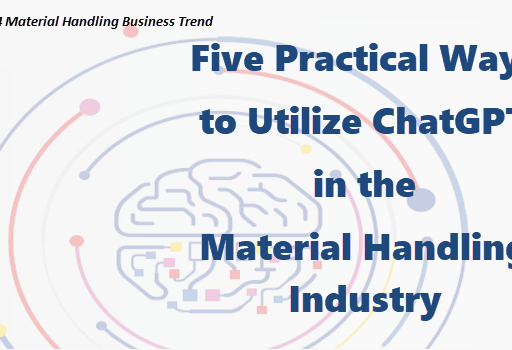2024 Material Handling Business Trend: Technology is profoundly impacting the material handling industry, including artificial intelligence, digital automation, datadriven decision-making and the integration of advanced systems that optimize efficiency, productivity and safety. Members must have a clear understanding of emerging technologies. View all 2024 Trends at www.mheda.org/trends.
By Sam Richter
The material handling industry has been a long-standing adopter of Artificial Intelligence (AI) and machine learning (ML) technologies. However, the concepts of generative AI and large language models (LLMs) are relatively new to many industry professionals.
One of the most renowned LLMs in the market today is OpenAI’s ChatGPT, an acronym for Chatbot Generative Pre-trained Transformer. This AI model can be accessed directly by creating a free account at https://chat.openai.com or downloading the mobile app. A premium account offers access to the latest LLM models and advanced features including plug-ins.
Understanding Generative AI and LLMs
Generative AI is a subset of artificial intelligence that focuses on creating new content. This content can range from textand images to music, synthetic voices and videos. Unlike traditional AI models that simply replicate existing content, Generative AI creates novel content that didn’t exist before.
These models are trained on vast amounts of data, enabling them to learn patterns and structures inherent in the information. ChatGPT’s LLM can generate human-like text based on the input it receives.
LLMs can be thought of as highly sophisticated auto-suggest engines. For example, when you enter a term into Google the engine instantly starts providing you options based on other searches that start out with the same letters.
However, LLMs take this to a whole new level. The “suggestion” is not a simple prediction but the result of sophisticated calculations analyzing millions of data points in real time. An LLM looks for patterns and then makes a next-word prediction.
For example, given the prompt “the color of the sky is,” the model will likely suggest “blue” as the next word. This prediction is based on the frequency with which the phrase “the color of the sky” and the word “blue” occur near each other in the LLM’s data.
What makes an LLM so powerful, however, is that the algorithms consider the context. For example, if you change the phrase to “at sunset, the color of the sky is,” the model is more likely to suggest “orange” or “red” as the next word. The LLM does not understand the concept of a sunset or the sky changing color. Yet, it has learned from its data that the words “orange” and “red” often follow the phrase “the sky is” when the word “sunset” is mentioned earlier in a given sentence. An LLM is able to make a best guess prediction of what word should appear next.
Another distinguishing feature of LLMs is how they present their responses. For example, ChatGPT presents in a detailed, confident manner that mimics the writing style of humans. This can cause problems because unlike in a Google auto-suggest where the user can choose from a list of options, with an LLM, you receive one response written in a way that appears factual and credible.
It’s crucial to understand that LLMs like ChatGPT are not some super-powered magical resources. LLMs do not understand the world as humans do. They do not have experience, and even though amazingly impressive, an LLM’s ability to provide context is limited to the statistical prediction models used in its training.
So, what does this mean for you? Now that you understand how Generative AI and LLMs like ChatGPT work, you can leverage them in your day-to-day activities. Following are some ways you might use ChatGPT in your business.
1. Sales
Streamlining Pre-call Research: Chat-GPT is not a search engine. It is not a powerful sales intel resource that leverages AI and ML, like the Intel Engine (www.intelngin.com/shipping-logistics). ChatGPT cannot find decision-makers or contact information as a generative versus rule-based AI. In fact, it’s prohibited from doing so.
However, it can streamline the data gathering process by helping you better understand the information that you find. For example, you could ask ChatGPT to summarize a prospect’s website or a news article. One way to do this is to use a ChatGPT plug-in that will look at the current internet. You can copy and paste LinkedIn profile information into Chat-GPT and have it summarized.
Enhancing Communications: In your ChatGPT prompt, enter relevant information about your prospect or customer, and then let ChatGPT craft an email, letter, LinkedIn message or even write a telephone script.
For example, prompt ChatGPT with information about a prospect, the company’s pain points or issues that are going on in their industry (e.g., hiring employees). Then, enter your company’s solutions to those pain points. Ask ChatGPT to address potential objections and suggest relevant solutions. The more you can personalize your messages based on what the other person cares about, the more effective your communication and the more credible you become.
Making Follow-up Easy (and Fun): Another way to leverage ChatGPT in sales is in your value-adding follow-up messages. We know that statistically, most salespeople stop contacting a prospect after three attempts. Yet we also know that most prospects don’t respond until somewhere between the fifth and 12th messages (and, in some industries, after more than 20). So how do you stay in touch with prospects and even existing customers in ways where you’re only sometimes selling and instead providing value to them?
Leverage ChatGPT to craft follow-up messages based on information the other person cares about. Find an article about their company and have ChatGPT write a congratulatory note. Locate a research report about their industry and send them a “stumbled across this online and immediately thought of you” message. You can automate the value-adding follow-up with GPT FollowUp, found at www.gptfollowup.com.
Sales Training: ChatGPT can be used as a sales training tool. Enter information about your company or product into Chat-GPT. Then, enter that you are a salesperson for the company, and you would like ChatGPT to act as a potential customer – make sure to provide details about who that might be, for example, a logistics manager at a food processing plant. Then, in your prompt, ask ChatGPT to role-play different scenarios.
2. Customer Support
ChatGPT can be used to write customer support scripts. Use a plug-in to upload your information and manuals into Chat-GPT and ask it to write customer support scripts. Use your existing scripts as a guideline and even enter real questions you receive. Ask ChatGPT to create different customer service scenarios and write factual, non-emotional, easy-to-understand responses. A good prompt is “Explain this to me as if I were a…” and then enter a job title, function or even “high school student.”
3. Marketing
Blog Post Creation: Use ChatGPT to draft engaging blog posts centered around your solutions. For example, paste in information about your product and then add a prompt such as “Write a blog post about the benefits and applications of our latest AIdriven forklift for warehouses.” You’ll receive a draft that you can then edit and personalize.
Email Campaign Personalization: ChatGPT can help create personalized email marketing content. Upload some product information, then try a prompt such as “Craft a persuasive introductory email for our new AGV product targeting warehouse managers interested in improving operational efficiency.”
Social Media Post Ideas: Upload product information and input prompts such as “Generate a LinkedIn post announcing our new palletizing robot and its impact on warehouse productivity.” Additionally, copy and paste content from a product brochure or your company website and ask ChatGPT to write 50 social media posts highlighting the benefits of working with you.
4. Finance
ChatGPT can be a valuable tool in creating and revising financial documents. Paste in your financial statement and then enter a prompt such as “Help me draft an outline for a corporate tax report considering the depreciation of our material handling equipment over the last fiscal year.” Or ask ChatGPT to “Provide a summary of this data indicating the financial performance of our forklift fleet, considering factors like maintenance costs, depreciation and downtime.”
5. Managing the Risks
While ChatGPT can be immensely beneficial, it’s crucial to understand and manage the risks associated with its use. Here are some important points to consider:
Fact-checking: ChatGPT can sometimes make up information yet communicate its answers in a confident manner that appears as fact. This happens because unless your prompt violates a preprogrammed guideline ChatGPT will always deliver a response. ChatGPT will search its trained data first for the obvious answer. ChatGPT will move on to what it believes is the next best prediction if nothing obvious exists. Make sure you double-check any data that ChatGPT presents.
Plagiarism: Don’t represent ChatGPT-generated content as your own. Yes, ChatGPT can create articles and blog posts for you. However, it’s best to use ChatGPT to craft an outline. If you use it to compose a paragraph or article, rewrite the content so it’s in your voice and you can add your experience and stories.
Bias: ChatGPT has no concept of emotion and empathy. Any content created by ChatGPT should be carefully reviewed to ensure it doesn’t contain language that your audience might deem offensive or discriminatory or use examples that portray someone or something negatively.
Data Privacy and Security: LLMs theoretically store your prompt inputs and use them to improve their training. To be blunt, no one knows what happens to the information you share with an LLM. Don’t input confidential information or proprietary intellectual property.
Generative AI offers immense potential for material handling organizations, from streamlining complex tasks to enhancing simple processes. However, it’s important to remember that no matter how innovative your technology tools are, you’re in a people business. Leverage ChatGPT, yet always remember that personalization, customization and relevant value will almost always win over automation and efficiency.
About the Author
Sam Richter is one of the world’s foremost Sales Intelligence and digital reputation experts. A national Hall of Fame speaker and a bestselling author, Sam is also the creator of the Intel Engine, GPT FollowUp, and many other AI and LLM-based products. Learn more at www.samrichter.com.



